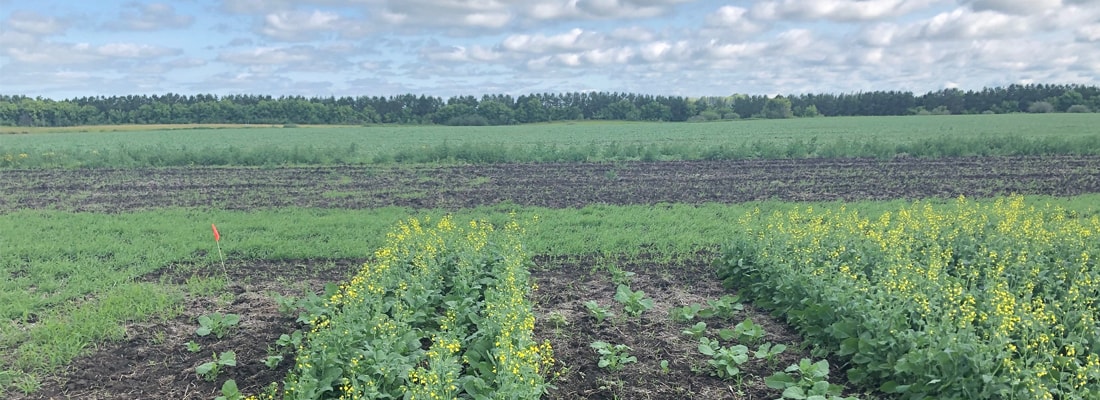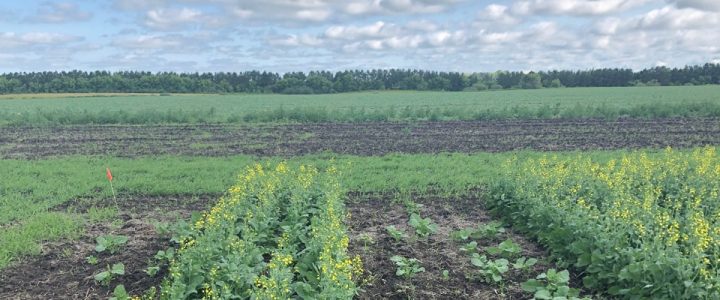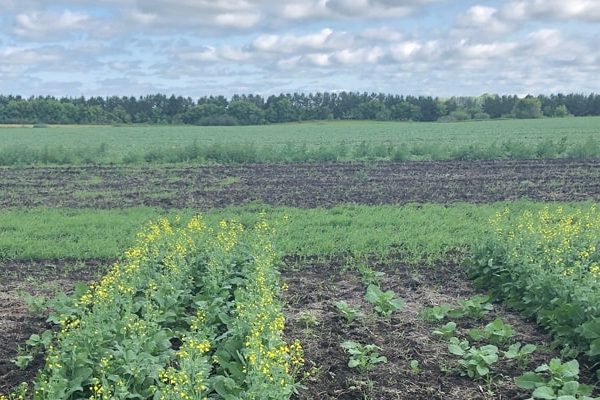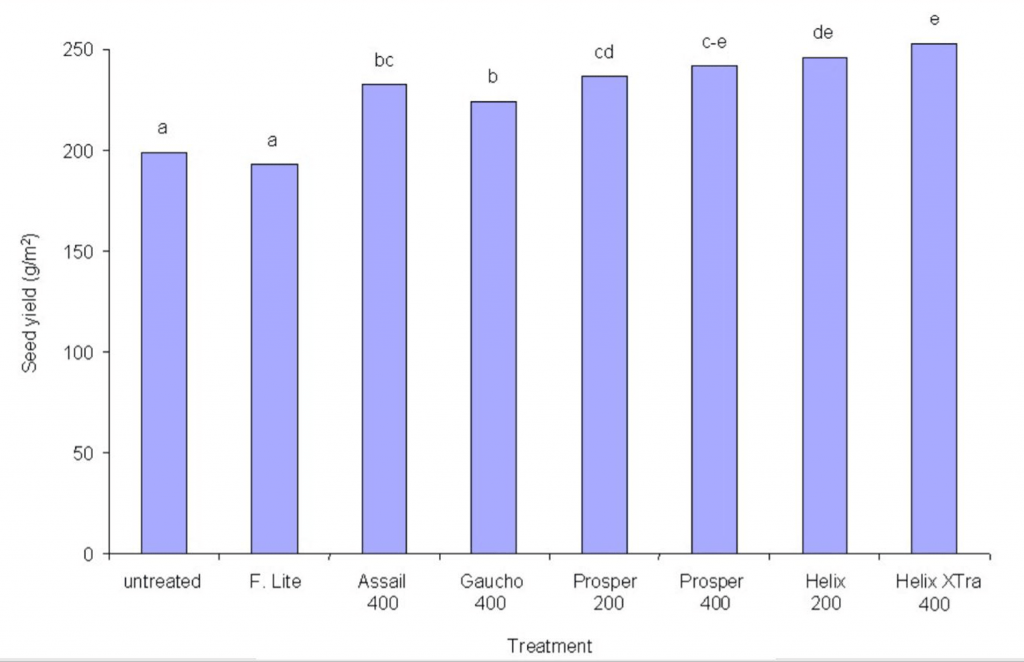Certified canola seed typically comes pre-treated with a combination of active ingredients (such as insecticide and pesticide seed treatments) to protect canola seed and seedlings from disease and insect pests. Insecticide seed treatments may reduce the need for foliar applications and may provide significant increase in yield.
Important tips for best management
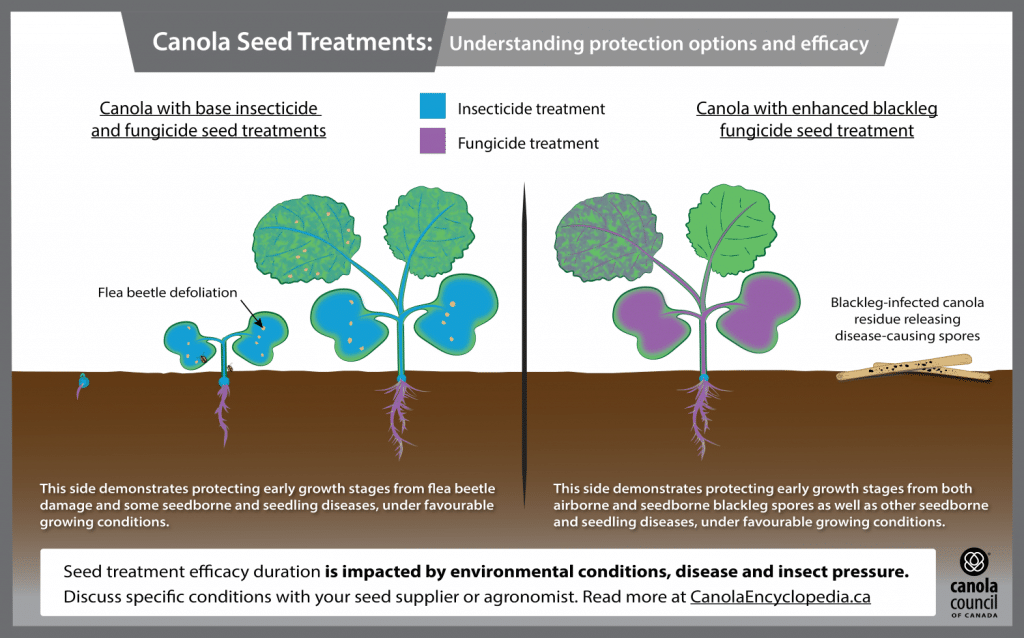
- Optimize seeding operations (seeding speed, depth, rate, etc.) to support rapid germination and emergence.
- Fungicide and insecticide seed treatments are targeted ways to protect canola seed and seedlings against flea beetles and seedling diseases (two major threats to canola crop establishment) and potentially provide a significant increase in yield potential.
- Insect and disease scouting is still required for treated seed and an insecticide spray could be necessary to control flea beetles if feeding damage exceeds thresholds.
- Seed treatment efficacy duration is impacted by environmental conditions, disease and insect pressure.
- Protection from seed treatments will decline over time as active ingredients break down. In some cases, this may happen before the crop has outgrown its most susceptible phase.
Seed treatment overview
There are base and enhanced insecticide and fungicide seed treatments available, which can offer canola protection in its early growth stages.
To maximize efficacy of insecticide and fungicide seed treatments and promote rapid emergence, it is recommended to plant canola 1.25 to 2.5 centimeters (0.5 to 1 inches) deep into a warm moist seedbed using a seeding rate that targets 50 to 80 plants/m2 (5-8 plants/ft2). This will help the crop quickly grow through the early growth stages when it is most susceptible to seedling diseases and flea beetle damage.
Favourable canola growing conditions also increase the chance of healthy plants which allows plants to better handle any stressors, including insect or disease pressure.
There are many commercially available seed treatments for canola, which are listed in Table 1. A seed pelleting technology from Syngenta Canada called Pelta™ is also available through through CANTERRA SEEDS for some canola cultivarsCultivars are variants in a species developed through the intervention of humans (despite the term 'variety' often being incorrectly used to describe this). Cultivars can be open-pollinated type, hybrid, synthetic, composite, etc. More.
Table 1. Seed treatments registered for canola
* LD50 values represent the relative toxicity of a pesticide. They represent the dose (in mg/kg body weight) that will kill 50% of the test animals. Thus the lower the number the greater the toxicity. Values given are for oral female rat LD50.
Note: Always read and follow current pesticide label directions.
Source: Guide to Crop Protection 2024 (Manitoba), The Blue Book (Alberta’s Crop Protection Guide), MSDS/Label Public data
Fungicide (base and enhanced) seed treatments
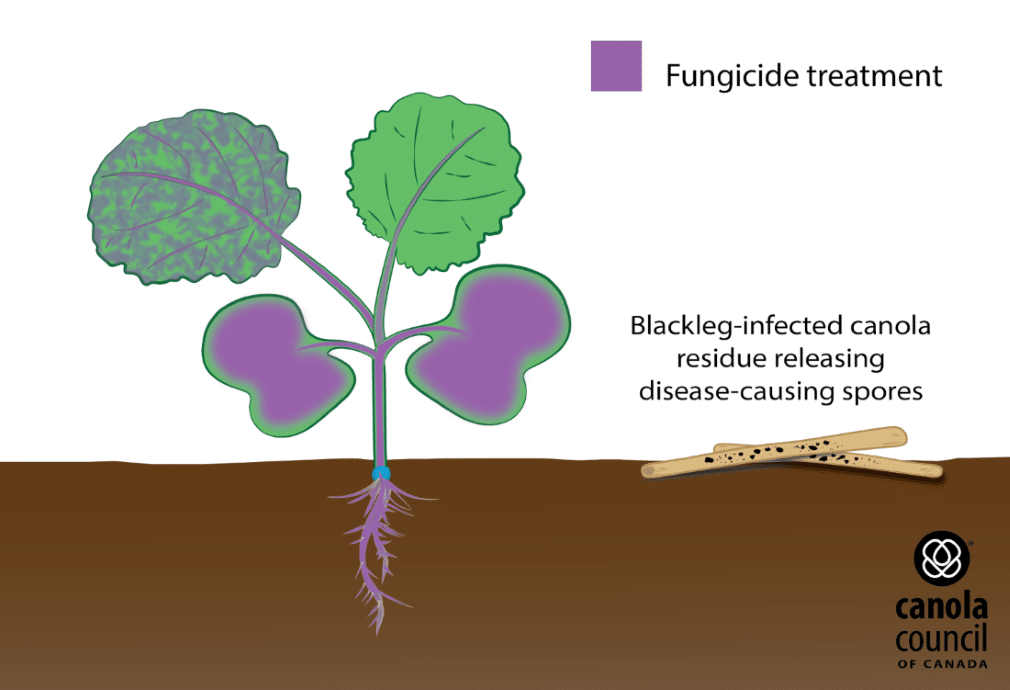
Canola seed and seedlings are vulnerable to a broad range of pathogens. Fungicide seed treatments can protect canola from the most common seedling disease-causing fungi, including Rhizoctonia solani and various Fusarium and Pythium species. Without fungicide seed treatments, canola seedlings are at much higher risk of seed rots, seedling blight and damping off. Learn more about root rots.
Fungicide seed treatments can also protect canola from seed-borne forms of blackleg and alternaria. As well, they can prevent the seed from introducing the pathogens to a field — or at a minimum, from increasing the inoculum levels for these diseases.
New enhanced fungicide seed treatments have the capability to protect plants from blackleg infections caused by both seed-borne and airborne inoculum. Pydiflumetofen and Fluopyram are the actives that belong to the chemical class of the Succinate Dehydrogenase Inhibitors (SDHI) which have been found to provide early season blackleg control 1.
Insecticide seed treatments
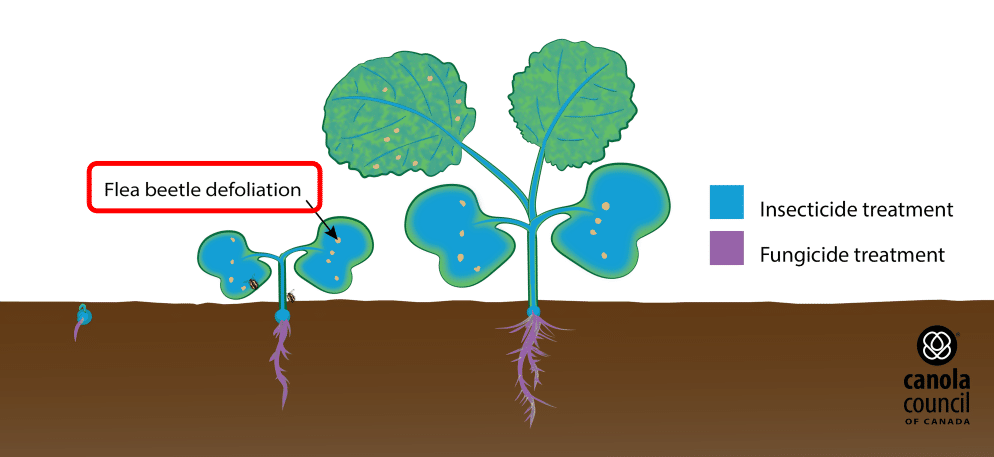
Insecticide seed treatments are widely used for canola in Canada. They can protect canola from flea beetles in the early growth stages depending on the insecticide active ingredient, rate and environmental conditions. Seed treatment is an effective way to provide protection because flea beetles are widespread across the Prairies and canola seedlings are vulnerable to feeding damage. High flea beetle populations can wipe out a crop quickly, sometimes even before a grower can respond with a foliar treatment. Seed treatments mitigate the risks associated with relying solely on foliar control, namely timing, coverage, and weather conditions such as rain or wind.
Agriculture and Agri-Food CanadaAgriculture and Agri-Food Canada is a department of the Government of Canada. More research found that insecticide seed treatments reduced flea beetle damage between nine and 90 per cent, depending on the product and the rate, when compared to untreated checks. By reducing damage, seed treatments improved seedling establishment from 61-64 per cent to 81-83 per cent, and yield by six to 27 per cent 2.
Additional research data has shown that research plots planted with insecticide seed treatment had six to 43 per cent more plants (24 per cent more plants on average) and resulted in up to a 46 per cent yield increase (16 per cent average yield increase) over non-treated plots. On a per field basis, seed treatments use less insecticide than a foliar spray because only the seed is coated, not a lot of other surrounding area. And seed treatments will limit damage to non-target and pollinator species 3.
The major disadvantage of insecticide seed treatments is that they are used prophylactically in anticipation of a pest problem. If the insect pest doesn’t arrive, then use of the insecticide seed treatment was not warranted. However, since no viable pest predictive model exists for flea beetle, despite decades of research investment, the use of broad acre applications of insecticide seed treatment is a key part of the integrated pest management strategy for this insect.
Only in specific instances can the use of prophylactic applications of insecticide be justified. These include: when rescue treatments cannot keep pests under the economic injury level, when target pests have a high probability of causing economic damage and when pests are widespread in their distribution and there is no practical or quantifiable way of determining where and when they will appear. In addition, it may be justified if alternative control treatments are less efficacious and introduce a greater economic burden which includes crop loss, increased costs, and negative impacts on non-target organisms 4.
Insecticide and fungicide seed treatments
Since canola plant establishment is so important and because canola seed is so valuable, fungicide and insecticide seed treatments are economical ways to provide the protection young canola seedlings need to survive 5.
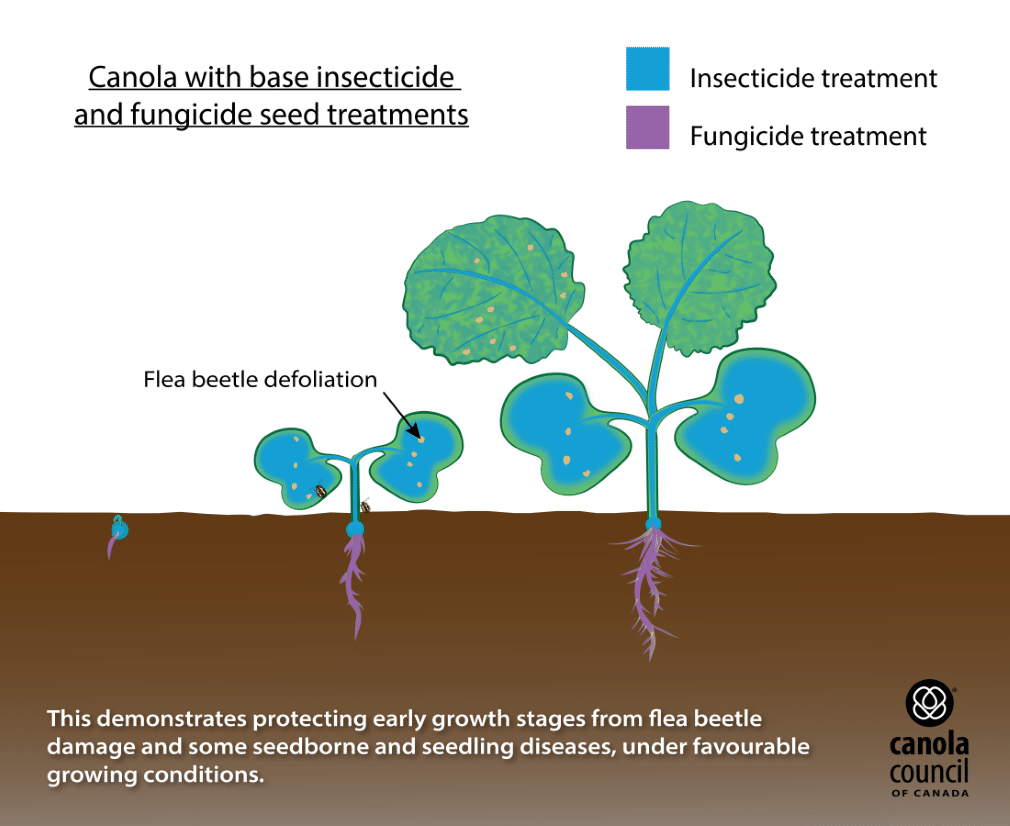
In order to maximize seed treatment effectiveness, seed canola into warm soils (five degrees Celsius or higher) and to proper depth (approximately two centimetres) to ensure rapid emergence. Delayed emergence due to deep seeding or cool soil temperature prolongs the time required for the crop to grow beyond the vulnerable early seedling stage. If a crop germinates but stays below ground for 14 days or more before emerging, the likelihood that seed treatment protection will run out before the crop advances beyond the four-leaf stage is greatly increased. Deep seeding also exposes the hypocotyls to more soil, increasing potential exposure to seedling disease fungi.
Canola with fungicide and insecticide seed treatments show a consistent benefit for canola plant establishment and yield when compared to fungicide-only seed treatments and to untreated seed 6. This project also illustrated that a mix of treated and untreated seed could provide the same economic benefit, while reducing the pesticide load per acre. A mix of 2/3 treated and 1/3 non-treated provided the same economic return as 100 per cent insecticide treated seed.
Seed treatments that provide the longest flea beetle protection usually provide the best seedling establishment, highest plant weight and highest seed yield. Differences among seed treatments were greater when flea beetle infestations were high than when infestations were low 5.
Currently all available canola hybrid seed is sold pre-treated (with a seed treatment). Seed treatment options in canola are almost exclusively registered for commercial treatment with a closed transfer system. A few varieties can be legally saved for a grower’s own use, but the grower would have to first check that they aren’t violating any legal obligations. Also, in addition to the insect and disease risks from planting untreated seed, research has demonstrated yield and economic advantages and agronomic disadvantages of growing farm-saved seed from hybrids rather than purchased hybrids 7. Therefore, planting certified treated seed is highly recommended.
Other treatments
Starter fertilizer treatments
Some seed treatments provide a mix of starter liquid fertilizer, often including phosphorus and micronutrients such as zinc or boron. Before making a significant investment in these products, test them for efficacy on limited acres on your own farm over a couple of years. Questions about conducting on-farm trials can be directed to the CCC Agronomy Specialist nearest you.
Many fertilizer products are registered, but the Canadian Food Inspection Agency (CFIA) rules for fertilizer products, including inoculants and enhancers, are not as strict as they are for pesticidesPesticides (herbicides, insecticides or fungicides) used to protect against or reduce the amount of damage caused by weeds, pest insects or plant diseases. More. Controlled release coatings, urease inhibitors and inoculant extenders, for example, do not fall under the regulatory authority of the Fertilizers Act. But when mixed with a fertilizer, the end product is regulated. The CFIA’s Crop Inputs Division encourages manufacturers of these products to seek a Letter of No Objection (LONO) from the CFIA to ensure that their use in fertilizers and supplements results in final products that meet safety and labelling standards. However, growers should note that any enhancers, extenders or seed-applied fertilizer products put into a custom fertilizer blend do not need to be registered, so they may have come into the marketplace without going through CFIA regulatory channels, and no longer need to provide proof of efficacy to be registered. For more information, see CFIA’s registered product list.
Bulking agents
Most drill tanks sold in western Canada are made to handle small seeds such as canola and deliver relatively uniform seed counts to each row. For a drill that cannot accurately meter small seeds and low flow rates, bulking agents such as safe seed-placed rates of material like phosphate fertilizer (11-52-0-0) may help.
The Canola Council of Canada trials in 2001 and 2002 (evaluating pelletized elemental sulphur at 22.5 kilograms per hectare, or 20 pounds per acre, as a seed-bulking agent) found no consistent stand establishment or yield benefit when using the bulking agent, indicating this practice is beneficial for ease of calibration more than providing direct economic gain.
Elemental sulphur will improve sulphur availability in following years, though. Bulking agents can also help when checking seed placement and drill performance. For example, the yellow sulphur prill should be found on the same plane as canola seeds.
Seed pelleting
In 2022 Syngenta launched Pelta™ seed pelleting technology. Pelta is offered for canola in combination with canola seed treatment packages. With this technology, canola seed is built up to a consistent, uniform size with a proprietary coating which claims to provide seeding operation and handling efficiencies with singulation technology. Pelta is marketed primarily to growers using planters to seed canola.
Footnotes
- Peng, G., Liu, X., McLaren, D.L., McGregor, L. & Yu, F. 2020. Seed treatment with the fungicide fluopyram limits cotyledon infection by Leptosphaeria maculans and reduces blackleg of canola. Canadian Journal of Plant Pathology, DOI: 10.1080/07060661.2020.1725132[↩]
- Elliot, B., Mann, L., & Olfert, O. 2007. Effect of neonicotinoid seed treatments on flea beetle damage and performance of Argentine canola (Brassica napusAlso referred to as Argentine canola, it is the species of canola currently commonly grown in Canada. More) in 2003-2006. CARP 2004-14.2. Retrieved from: https://www.saskcanola.com/quadrant/System/research/reports/Elliott.CARP2004-14.2argentine.FN.pdf[↩]
- Sekulic G., & Rempel, C.B. 2016. Evaluating the Role of Seed Treatments in Canola/Oilseed Rape Production: Integrated Pest Management, Pollinator Health, and Biodiversity. Plants (Basel), 5(3), 32. https://doi:10.3390/plants5030032[↩]
- Douglas, M. & Tooker, J. 2015. Large-Scale Deployment of Seed Treatments Has Driven Rapid Increase in Use of Neonicotinoid Insecticides and Preemptive Pest Management in U.S. Field Crops. Environmental science & technology. 49. 10.1021/es506141g[↩]
- Elliot, R.H. 2005. Effect of seed treatments on flea beetle damage and the performance of open-pollinated and hybrid Argentine canola. CARP Project # 2003-02-01-19.[↩][↩]
- Soroka, J., Grenkow, L., & Irvine, R. 2009. Impact of Decreasing Ratios of Insecticide-Treated Seed on Flea Beetle (Coleoptera: Chrysomelidae, Phyllotreta spp.) Feeding Levels and Canola Seed Yields. Journal of economic entomology, 101(6), 1811–1820. https://doi.org/10.1603/0022-0493-101.6.1811[↩]
- Smith, E., Favret, M., Clayton, G., Blackshaw, R., Brandt, S., Johnson, E., Harker, K., O’Donovan, J., Kutcher, H., & Vera, C. 2010. The Profitability of Seeding the F Generation of Hybrid Canola. Agronomy Journal – AGRON J. 102(2), 598-605. https://doi.org/10.2134/agronj2009.0101[↩]
